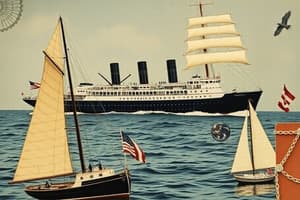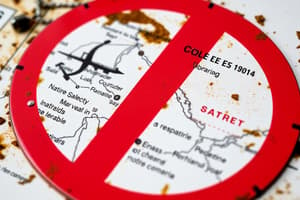Podcast
Questions and Answers
Which statement best describes the role of the International Maritime Organization (IMO) in relation to navigation rules?
Which statement best describes the role of the International Maritime Organization (IMO) in relation to navigation rules?
- The IMO sets guidelines for medical emergencies at sea.
- The IMO establishes navigation rules and governs COLREGs. (correct)
- The IMO manages international fishing quotas.
- The IMO regulates commercial shipping tariffs.
What is the primary responsibility of a 'give way' vessel when encountering a 'stand-on' vessel?
What is the primary responsibility of a 'give way' vessel when encountering a 'stand-on' vessel?
- Take action to avoid collision. (correct)
- Signal the stand-on vessel to adjust course.
- Increase speed to pass quickly.
- Maintain its course and speed.
Under what circumstance does a sailing vessel under engine power need to follow the same rules as power-driven vessels?
Under what circumstance does a sailing vessel under engine power need to follow the same rules as power-driven vessels?
- When it is not under sail. (correct)
- When it is towing another vessel.
- Only when navigating in narrow channels.
- At night or in poor visibility.
What type of vessel generally has the right of way over power-driven vessels?
What type of vessel generally has the right of way over power-driven vessels?
What is the main purpose of COLREGs as established by the United Nations Convention on the Law of the Sea (UNCLOS)?
What is the main purpose of COLREGs as established by the United Nations Convention on the Law of the Sea (UNCLOS)?
What is a recommended strategy for collision avoidance at sea?
What is a recommended strategy for collision avoidance at sea?
In restricted visibility, what is a crucial action vessels should take according to navigation rules?
In restricted visibility, what is a crucial action vessels should take according to navigation rules?
What is a common maneuver to avoid collisions in narrow channels?
What is a common maneuver to avoid collisions in narrow channels?
What is the primary responsibility of a 'stand-on vessel' when encountering a 'give-way vessel'?
What is the primary responsibility of a 'stand-on vessel' when encountering a 'give-way vessel'?
Which scenario requires a sailing vessel to yield to another vessel?
Which scenario requires a sailing vessel to yield to another vessel?
According to navigation rules, what action must a vessel take when assessing the risk of collision?
According to navigation rules, what action must a vessel take when assessing the risk of collision?
Which of the following describes a key responsibility under Rule 5 of the COLREGs?
Which of the following describes a key responsibility under Rule 5 of the COLREGs?
What must a sailing vessel do when it encounters another sailing vessel on the same tack?
What must a sailing vessel do when it encounters another sailing vessel on the same tack?
Under what condition must power-driven vessels yield to sailing vessels?
Under what condition must power-driven vessels yield to sailing vessels?
What technology is recommended to assist with collision avoidance, particularly in poor visibility?
What technology is recommended to assist with collision avoidance, particularly in poor visibility?
What is a key factor when determining a safe speed according to the COLREGs?
What is a key factor when determining a safe speed according to the COLREGs?
Which type of vessel has the highest right of way in any situation?
Which type of vessel has the highest right of way in any situation?
What is a fundamental requirement when using sound signals to indicate intentions?
What is a fundamental requirement when using sound signals to indicate intentions?
Flashcards
Navigation Rules
Navigation Rules
Rules established by the International Maritime Organization (IMO) and governed by the International Regulations for Preventing Collisions at Sea (COLREGs).
Stand-on Vessel
Stand-on Vessel
The vessel that maintains its course and speed and has the right of way.
Give-Way Vessel
Give-Way Vessel
The vessel required to take action to avoid a collision.
Sailing Vessel Conduct
Sailing Vessel Conduct
Signup and view all the flashcards
International Maritime Regulations
International Maritime Regulations
Signup and view all the flashcards
Collision Avoidance Strategies
Collision Avoidance Strategies
Signup and view all the flashcards
Situational Awareness
Situational Awareness
Signup and view all the flashcards
Sound Signals
Sound Signals
Signup and view all the flashcards
COLREGs
COLREGs
Signup and view all the flashcards
Rule 5
Rule 5
Signup and view all the flashcards
Rule 6
Rule 6
Signup and view all the flashcards
Rule 7
Rule 7
Signup and view all the flashcards
Sailing vessel right of way
Sailing vessel right of way
Signup and view all the flashcards
Windward vs. Leeward Vessels
Windward vs. Leeward Vessels
Signup and view all the flashcards
Tacking
Tacking
Signup and view all the flashcards
Jibing
Jibing
Signup and view all the flashcards
Equipment and Signals
Equipment and Signals
Signup and view all the flashcards
Power vs. Sailing vessel
Power vs. Sailing vessel
Signup and view all the flashcards
Study Notes
Navigation Rules
- Established by the International Maritime Organization (IMO).
- Governed by the International Regulations for Preventing Collisions at Sea (COLREGs).
- Apply to all vessels on the water, including power-driven, sailing, and fishing vessels.
Right of Way
- "Stand-on" vessel: Maintains course and speed.
- "Give way" vessel: Must take action to avoid collision.
- Key factors affecting right of way:
- Vessel type (power-driven vs. sailing).
- Direction of travel (head-on, crossing, overtaking).
- Size and maneuverability of vessels.
Sailing Vessel Conduct
- Sailing vessels under sail generally have the right of way over power-driven vessels.
- When under engine power, a sailing vessel must follow the same rules as power-driven vessels.
- Special considerations for sailing vessels:
- Avoidance of collisions with larger vessels.
- Use of signals for intentions (e.g., sound signals).
International Maritime Regulations
- Governed by the United Nations Convention on the Law of the Sea (UNCLOS).
- COLREGs consist of 38 rules divided into:
- Part A: General (definitions, applicability).
- Part B: Conduct of Vessels in any Condition of Visibility.
- Part C: Conduct of Vessels in Restricted Visibility.
- Part D: Exemptions (small vessels).
Collision Avoidance
- Key strategies:
- Maintain a proper lookout (visual and auditory).
- Determine risk of collision and take action early.
- Use navigation lights and sound signals to communicate intentions.
- Follow safe speeds suitable for conditions.
- Types of maneuvers:
- Altering course or speed to avoid collision.
- Passing clear of other vessels, particularly in narrow channels.
Understanding and adhering to these rules and regulations is essential for safety and navigation at sea.
Navigation Rules
- Established by the International Maritime Organization (IMO) to enhance maritime safety.
- Governed by the International Regulations for Preventing Collisions at Sea (COLREGs).
- Apply to all types of vessels, including power-driven, sailing, and fishing vessels.
Right of Way
- "Stand-on" vessel retains course and speed; does not take evasive action.
- "Give way" vessel must actively avoid collision and take appropriate measures.
- Right of way is influenced by:
- Type of vessel (power-driven vs. sailing).
- Direction of travel (head-on, crossing paths, overtaking).
- Size and maneuverability, affecting decision-making.
Sailing Vessel Conduct
- Under sail, sailing vessels typically have precedence over power-driven vessels.
- When using engine power, sailing vessels must comply with the same rules as power-driven vessels.
- Special considerations for sailing vessels include:
- Need to avoid collisions, particularly with larger vessels.
- Requirement to use sound signals to indicate intentions.
International Maritime Regulations
- Regulated by the United Nations Convention on the Law of the Sea (UNCLOS).
- COLREGs comprise 38 rules organized into four parts:
- Part A: General rules, definitions, and applicability.
- Part B: Conduct of vessels under visibility.
- Part C: Conduct of vessels under restricted visibility.
- Part D: Exemptions applicable to small vessels.
Collision Avoidance
- Essential strategies include:
- Maintaining a proper lookout using visual and auditory methods.
- Early assessment of collision risks and prompt action.
- Use of navigation lights and sound signals to communicate intentions.
- Adhering to safe speeds appropriate for navigational conditions.
- Recommended maneuvers involve:
- Altering course or speed to avoid potential collision.
- Passing clear of other vessels, especially in narrow channels.
- Adherence to these rules is crucial for safety and effective navigation at sea.
Right of Way
- Stand-On Vessel: Maintains course and speed, has the right of way.
- Give-Way Vessel: Must yield to the stand-on vessel to prevent collision.
- Power-Driven vs. Sailing Vessels: Power-driven vessels yield to sailing vessels unless overtaken.
- Fishing Vessels: Sailing vessels must give way to fishing vessels with restricted maneuverability.
- Vessels Not Under Command: Have the right of way over all other vessels.
Collision Avoidance
- Situational Awareness: Continuous surveillance of surroundings is crucial to identify collision risks.
- Radar Use: Important for detecting vessels, especially in low visibility conditions.
- Sound Signals: Necessary to communicate intentions, such as using horn blasts.
- Maneuvering: Adjust course and speed well in advance to ensure safe distance from other vessels.
Navigation Rules
- COLREGs: International rules designed to govern marine vessel conduct and prevent collisions.
- Rule Categories:
- Part A: Defines terms and outlines application.
- Part B: Governs conduct in all visibility conditions.
- Part C: Governs conduct in restricted visibility.
- Part D: Details exemptions for specific vessels.
- Key Rules:
- Rule 5: A lookout must always be maintained.
- Rule 6: Vessels must operate at a safe speed to avoid collisions.
- Rule 7: Vessels must assess the risk of collision.
Sailing Vessel Conduct
- Right of Way: Sailing vessels under sail have priority over power-driven vessels.
- Windward vs. Leeward Vessels: The windward vessel must yield to the leeward vessel when two sailing vessels approach.
- Tacking: When turning the bow through the wind, remain vigilant of surrounding vessels.
- Jibing: Ensure a clear path when turning the stern through the wind to prevent collisions.
- Equipment and Signals: Necessary to display correct daytime and nighttime lights; use sound signals to communicate maneuvers.
Studying That Suits You
Use AI to generate personalized quizzes and flashcards to suit your learning preferences.




